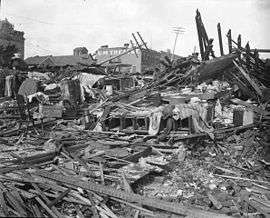1919 Fergus Falls tornado
The 1919 Fergus Falls tornado was a large and destructive tornado that struck Fergus Falls, Minnesota on Sunday, June 22, 1919. It killed 57 people and is the second deadliest tornado in Minnesota's history (1st was the 1886 Sauk Rapids tornado). This tornado occurred just 10 months after a tornado in Tyler, Minnesota killed 36 people. That twister was Minnesota's fourth deadliest on record.[1]
| F5 tornado | |
|---|---|
 Destruction from the Fergus Falls Tornado | |
| Formed | June 22, 1919 4:46 pm |
| Max. rating1 | F5 tornado |
| Damage | $4 million ($58,987,000 in 2020) |
| Casualties | 57 fatalities |
| Areas affected | Central Minnesota |
| 1Most severe tornado damage; see Fujita scale | |
The tornado
The tornado had a path of 20 miles (32 km), and at times was 400 yards (366 m) wide. It hit Fergus Falls at approximately 4:46 pm, and according to witness accounts was a "blank funnel shaped twisting cloud, or possibly several of them".[2] Though the Fujita scale did not exist at that time, it is estimated to have been an F5 based on descriptions and photographs of the damage.[3]
Damage
The tornado tore through the northern part of town, leveling 44 city blocks (including the business district), destroying 159 homes and damaging 250 more, some of which were swept completely away. Of the 57 people who died, at least 35 of them were in the Grand Hotel, a three-story, 100 room hotel which was completely flattened. Two hundred more were injured. The tornado also destroyed the Otter Tail County courthouse, the county jail, four churches and multiple other businesses. Small trees in town were debarked, and railroad tracks were reportedly pulled from the ground at one location, indicative of extreme intensity.[4] The Northern Pacific rail depot was completely destroyed, and reportedly swept away. At Lake Alice, several summer homes were swept into the water along with their occupants, resulting in several fatalities there.[5] The Great Northern Oriental Limited passenger train was thrown off the tracks by the tornado, but none of the 250 passengers on the train was seriously injured. Checks that were sucked up by the tornado in Fergus Falls were found 60 miles to the east.[2][6]
See also
References
- "Minnesota Tornado History and Statistics". Minnesota Climatology Office. May 21, 2007. Archived from the original on 11 August 2007. Retrieved August 30, 2007.
- "Tornado at Fergus Falls Minnesota, June 22, 1919" (PDF). Monthly Weather Review. 47 (6): 392–393. June 1919. Bibcode:1919MWRv...47..392.. doi:10.1175/1520-0493(1919)47<392:TAFFMJ>2.0.CO;2. Retrieved August 30, 2007.
- Seeley, Mark W. (2006). Minnesota Weather Almanac. Minnesota Historical Society press. pp. 188–189. ISBN 0-87351-554-4.
- Kellenbenz, David (1 July 2009). "Fergus Falls F5 Tornado of June 22, 1919". Grand Forks, North Dakota: National Weather Service. Retrieved 16 April 2014.
- "Tornado Wrecked Town, Killing 60" (PDF). New York Times. New York City. June 24, 1919. Retrieved 11 September 2013.
- "Fergus Falls, Minnesota Tornado June 22, 1919". gendisasters.com. Retrieved May 25, 2011.
External links
- Gendisasters.com
- NWS Grand Forks article of the Fergus Falls tornado
- [www.silly.com]
